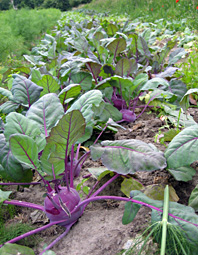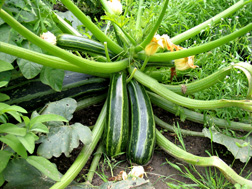Organic Gardening – Getting Started
Work with Nature
Organic gardening is essentially about growing crops by working with nature in contrast to the alternative approach, which attempts to control and overcome those aspects of nature that appear to be against what we want to achieve.
There is a great deal of debate about the merits or otherwise of organic gardening. Many gardeners view it with suspicion, believing it is making life more difficult than necessary for little or no tangible benefit.
At the other extreme, are those who believe that working closely with nature in every way we can is good for the plants, good for our health and good for the planet. In fact, for these same reasons, many people are prepared to pay a premium in the supermarkets for produce that has been grown organically.
Between these two extremes there is a wide range of opinions with many gardeners espousing the basic philosophy behind organic gardening but being prepared to enlist chemical help to deal with the more difficult garden pests.
Gardeners who prefer organic methods employ a wide variety of techniques, but most can be grouped under the following three headings:
Read Also:
- Getting Started with Organic Gardening
- Garden Paths
- Planting a Hedge
- Laying a Hedge
- Planning a Rock Garden
- Dry Stone Walling
- Masonry Walls
- Gardening Skills
Benefits of Organic Gardening
Some of the main reasons given for pursuing organic methods of growing are:
- It is more friendly to the environment because there is less possibility of pollution from man-made chemicals.
- For similar reasons, it is friendlier to wildlife, which is less likely to ingest harmful substances that may then be passed on up the food chain. Harvested crops that are intended for human consumption may also have chemical residues.
- It is a more sustainable approach to gardening, since many synthetically produced fertilizers and pest control chemicals are made from dwindling resources and consume energy in their production.
- The results are considered to be superior. In particular, fruit and vegetables that are organically grown taste better and are considered to be better for your health.
Productive Soil

Any form of gardening relies on good fertile soil.
The organic gardener achieves this by natural methods, which generally means feeding with homemade compost, leaf mould and other composted materials such as bark.
Depending on how confident you are about the sources, you may also purchase manure from stables, farmyard or even the local council – more and more of whom are composting garden rubbish.
Producing your own compost isn't difficult. There are many designs for compost bins that you can either make yourself or purchase relatively cheaply from garden centres. Most councils in the UK offer subsidised bins that they supply and deliver for a nominal payment.
You will probably want to position your bin in a discrete corner of the garden. If however you don't have anywhere to hide it, you can improve its appearance by growing flowers or other crops that will grow in the compost even while it is decomposing.
You can then fill your compost bin with appropriate waste materials from the garden and the kitchen that you might otherwise have thrown away. See "Make Your Own Compost" for more information about what and how to compost
You can produce leaf mould by collecting fallen leaves and storing them in black plastic bags. Tie off each full bag and place a weight on top, such as a large stone. You also need to puncture a few holes in the bottom of each bag to allow moisture to escape. It may take some months or even a year or two for the leaves to rot down, depending on what type of leaves you have collected, but the result will be excellent mulch and conditioner for your soil.
In general, you want a well-balanced soil that is easy to work and holds just enough moisture and nutrients. See Types of Soil, Testing Your Soil and Starting a Compost Heap for more information.
Select Healthy Plants

Just like humans, plants that are strong and healthy tend to be inherently more resistant to disease and other pests.
A healthy plant is one that starts off without any kind of pest or disease and which is growing in conditions that it finds to be ideal.
For this reason, when you have a choice, it is better to select plants and varieties that are native to your area – to your type of soil and your climate. You should also acquire your plants from a trusted source so that you can be sure they are disease free and have been grown from strong healthy stock.
The ultimate source for new plants is to raise your own, either from seeds that you have collected yourself or by taking cuttings from your own plants that you know are pest free
Alternatively, modern breeding techniques mean that you can buy varieties that are particularly resistant to certain diseases that may be prevalent in your area.
Read Also:
- Getting Started with Organic Gardening
- Garden Paths
- Planting a Hedge
- Laying a Hedge
- Planning a Rock Garden
- Dry Stone Walling
- Masonry Walls
- Gardening Skills
